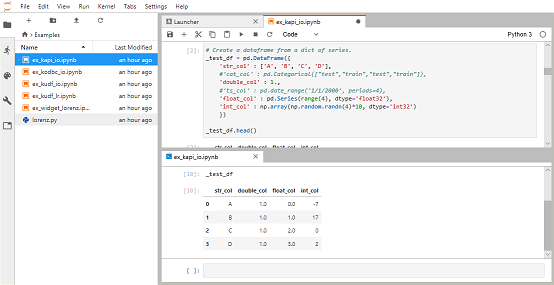

It kind of makes sense - they did see the 404 page and it was screaming louder than the traceback (which itself was already scrolled up as new messages appeared in the meantime - especially common when multiple jupyter_server extensions are installed!). I was helping a user who had a startup error due to conda/pip conflict ( #146 (comment)) and it struck me that they did not really post their tracback in the question, but instead titled it "404 : Not Found You are requesting a page that does not exist!". Thanks! Expose more file metadata about disk-backed content A bug report can be filed in the tracker at. Please also report this if it was a user error, so that a better error message can be provided next time.
#JUPYTERLAB APPUTILS FULL#
done Traceback (most recent call last): File "/usr/lib/python3.8/site-packages/sphinx/cmd/build.py", line 272, in build_main app = Sphinx(args.sourcedir, nfdir, args.outputdir, File "/usr/lib/python3.8/site-packages/sphinx/application.py", line 237, in _init_ (self) File "/home/tkloczko/rpmbuild/BUILD/jupyterlab_server-2.13.0/docs/source/conf.py", line 107, in setup exec(compile(f.read(), "./autogen_config.py", "exec"), ) File "./autogen_config.py", line 46, in FileNotFoundError: No such file or directory: '/home/tkloczko/rpmbuild/BUILD/jupyterlab_server-2.13.0/source/api/app-config.rst' Exception occurred: File "./autogen_config.py", line 46, in FileNotFoundError: No such file or directory: '/home/tkloczko/rpmbuild/BUILD/jupyterlab_server-2.13.0/source/api/app-config.rst' The full traceback has been saved in /tmp/sphinx-err-497h0cal.log, if you want to report the issue to the developers. Once JupyterLab opens in your browser, click the “Commands” icon, and search for “Sample React Redux Extension”.Running Sphinx v4.5.0 /usr/lib/python3.8/site-packages/pkg_resources/_init_.py:123: PkgResourcesDeprecationWarning: 1.17.1-unknown is an invalid version and will not be supported in a future release warnings.warn( making output directory. You’re all ready to go! Start both watch modes, and you’re in business! It provides a set of boilerplate best practices to get your project hooked up and running quickly. I’ve used redux-toolkit to manage the application’s store - if you’re not familiar with redux-toolkit, it is essentially the CreateReactApp of Redux. That’s pretty much it! can be any valid React that you’d like - this render function is similar to a normal React app’s index.tsx entry point.

Note: I haven’t experimented with Context yet in the JupyterLab setting, but theoretically you would wrap your ContextProvider around here as usual. We override the render function and set up our (which will handle our Redux store), and we render our. We create a new class called ReactAppWidget, which extends ReactWidget. A MainAreaWidget is created, and we will attach our React app to that widget by extending JupyterLab’s ReactWidget. There is an extension object that runs everything (located in index.ts). Okay, so the gist of how a JupyterLab extension works is this. Or… try my script to automatically open two tabs and run watch mode in both of them.


 0 kommentar(er)
0 kommentar(er)
